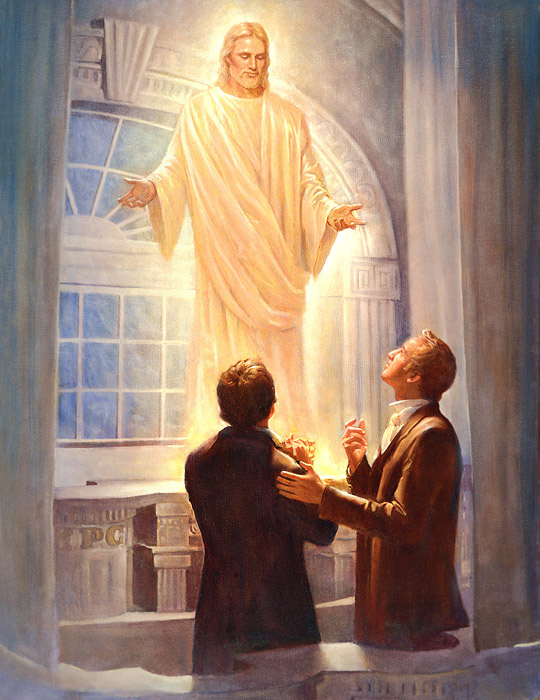 |
| Del Parson, Christ Appears to Joseph Smith and Oliver Cowdery in the Kirtland Temple. |
After the Saints reluctantly left their beloved temple, they were commanded to build another in Nauvoo. There God revealed that ordinances are vital not only for the living but also the dead who had not received that opportunity during their lifetime. These revelations reaffirmed New Testament teachings and gave new emphasis. For example, in Luke 4:18, Jesus Christ quoted the messianic promise of opening the prison to set the captives free (see Isaiah 61:1). He later taught the Pharisee Nicodemus, "Except a man be born of water and of the Spirit, he cannot enter into the kingdom of God" (John 3:5). Church members, believing in the salvational nature of the Atonement of Jesus Christ and the command to be baptized, began performing proxy baptisms for deceased ancestors and others, trusting that the dead could be released from prison (see 1 Peter 4:6). As the Apostle Paul said, "Else why are they then baptized for the dead?" (1 Corinthians 15:29).
On January 19, 1841, Joseph Smith recorded an injunction to build a temple in Nauvoo and to have the Saints begin baptizing by proxy when it was ready (see Doctrine and Covenants 124). He compared baptisms for the dead to welding links that bind us to our ancestors. Within the context of the challenges faced in Nauvoo, he wrote a stirring letter of encouragement about performing baptisms for the dead: "Shall we not go on in so great a cause? Go forward and not backward. Courage, brethren; and on, on to the victory! Let your hearts rejoice, and be exceedingly glad. Let the earth break forth into singing. Let the dead speak forth anthems of eternal praise to the King Immanuel, who hath ordained, before the world was, that which would enable us to redeem them out of their prison; for the prisoners shall go free" (Doctrine and Covenants 128:23).
Fast forward to 2015. Over the Thanksgiving holiday, several of our extended family members visited the Boise Idaho Temple and performed baptisms for the dead. What a joy that was! Today our son Jacob spoke in church about how temple work and family history work go hand in hand, sharing gratitude for his mom's help in researching. Shall we not go in in so great a work? Let's go forward and not backward. Courage, and on to the victory! Let the dead speak forth anthems of eternal praise to the King Immanuel!
On January 19, 1841, Joseph Smith recorded an injunction to build a temple in Nauvoo and to have the Saints begin baptizing by proxy when it was ready (see Doctrine and Covenants 124). He compared baptisms for the dead to welding links that bind us to our ancestors. Within the context of the challenges faced in Nauvoo, he wrote a stirring letter of encouragement about performing baptisms for the dead: "Shall we not go on in so great a cause? Go forward and not backward. Courage, brethren; and on, on to the victory! Let your hearts rejoice, and be exceedingly glad. Let the earth break forth into singing. Let the dead speak forth anthems of eternal praise to the King Immanuel, who hath ordained, before the world was, that which would enable us to redeem them out of their prison; for the prisoners shall go free" (Doctrine and Covenants 128:23).
Fast forward to 2015. Over the Thanksgiving holiday, several of our extended family members visited the Boise Idaho Temple and performed baptisms for the dead. What a joy that was! Today our son Jacob spoke in church about how temple work and family history work go hand in hand, sharing gratitude for his mom's help in researching. Shall we not go in in so great a work? Let's go forward and not backward. Courage, and on to the victory! Let the dead speak forth anthems of eternal praise to the King Immanuel!




No comments:
Post a Comment